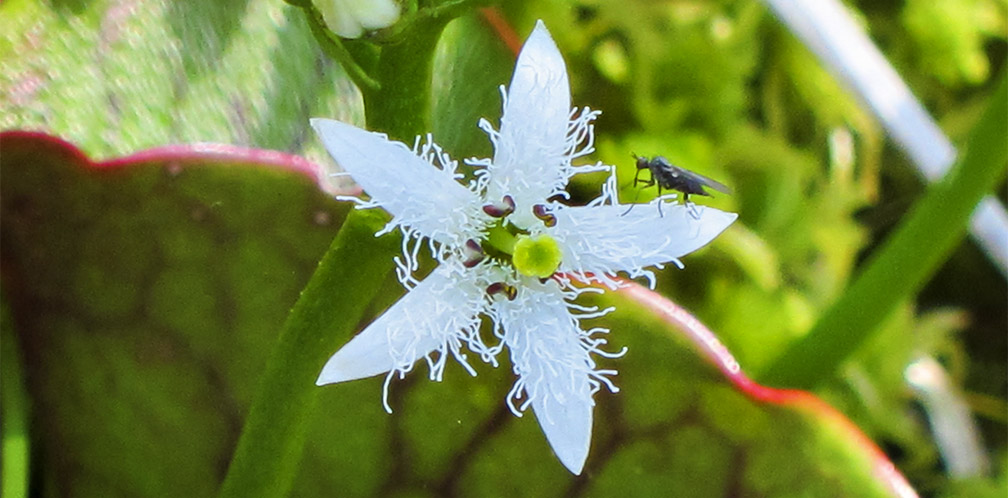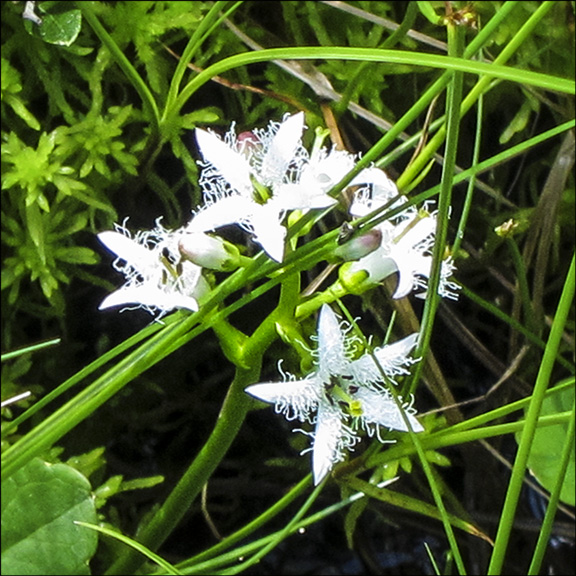Wildflowers of the Adirondacks:
Buckbean (Menyanthes trifoliata)

Buckbean (Menyanthes trifoliata) is a native wildflower that grows in bogs in the Adirondacks of upstate New York. Its star-like, white flowers appear in late spring.
The scientific name "trifoliata" is a reference to the fact that the leaves consist of three leaflets. This plant is also called Bogbean. The common name refers to its small, bean-like seeds.
Identification of Buckbean

Buckbean grows up to about ten inches tall. Its leaves are stalked. At the top of the leaf stalk are three smooth, rounded leaflets about 2.5 inches long.
Buckbean produces clusters of white or purple-tinged, star-like flowers emerging from stout stalks. Each flower is about a half inch wide, with five or six pointed lobes covered with short hairs, giving the flowers a fuzzy appearance. In the Adirondack region, Buckbean flowers in late May and early June.
Buckbean fruit is a capsule, with many small, hard seeds. The smooth, shiny seeds are bean-like, giving Buckbean its common name.
Uses of Buckbean
Buckbean has been used as both a food and a medicine. In Europe, the leaves were sometimes used as a substitute for hops in beer brewing and were also boiled in honey to make mead. Powdered Buckbean roots were reportedly mixed with flour as a bread additive.
Various medicinal applications of this species have been recorded. Buckbean has been used to treat many ailments, including jaundice, indigestion, skin diseases, scurvy, intestinal worms, and rheumatism. Small doses of this plant are said to impart vigor to the stomach and aid digestion. However, large doses may cause abdominal pains, nausea, and vomiting.
Wildlife Value of Buckbean
Buckbean has limited wildlife value. However, it is part of a wetland environment that is critical to some species of birds. Buckbean is found in bogs which form an important breeding habitat of a number of birds including:
Palm Warbler
Yellow-Bellied Flycatcher
Olive-sided Flycatcher
Alder Flycatcher
Cedar Waxwing
Common Yellowthroat
Wilson's Snipe
Distribution of Buckbean
Buckbean may be seen in bogs from Labrador to Alaska, south to Virginia, Missouri, and California.
In New York State, Buckbean is present in most counties in the eastern part of the state. With the exception of Saratoga County, Buckbean is found in all counties within the Adirondack Park Blue Line.
Habitat of Buckbean
Buckbean grows in bogs, poor to rich fens, rich swamps, and cool springy forests. It flourishes in wet soil or shallow water on the edges of ponds and in marshy ground, usually in acid soils. This plant is found in several ecological communities in the Adirondack Park, including Medium Fen, Red Maple-Tamarack Peat Swamp, and Rich Graminoid Fen. A convenient place to find Buckbean is on Barnum Bog, which can be accessed from the Boreal Life Trail boardwalk.
References
Michael Kudish. Adirondack Upland Flora: An Ecological Perspective (The Chauncy Press, 1992), p. 180.
New York Flora Association. New York Flora Atlas. Buck-bean. Menyanthes trifoliata L. Retrieved 18 March 2017.
United States Department of Agriculture. The Plants Database. Buckbean. Menyanthes trifoliata L. Retrieved 18 March 2017.
New York State. Department of Environmental Conservation. New York Natural Heritage Program. Ecological Communities of New York State. Second Edition (March 2014), pp. 58-59, 60, 73-74. Retrieved 17 October 2015.
New York Natural Heritage Program. 2015. Online Conservation Guide for Medium Fen. Retrieved 14 March 2017.
New York Natural Heritage Program. 2015. Online Conservation Guide for Rich Graminoid Fen. Retrieved 14 March 2017.
New York Natural Heritage Program. 2015. Online Conservation Guide for Red Maple-Tamarack Peat Swamp. Retrieved 6 March 2017.
New York State. Adirondack Park Agency. Preliminary List of Species Native Within the Adirondack Park Listed Alphabetically by Scientific Name and Sorted by Habit. Volume 1. Updated 10.23.2006, p. 28. Retrieved 26 January 2017.
Lady Bird Johnson Wildflower Center. Native Plant Database. Retrieved 18 March 2017.
Plants for a Future. Database. Retrieved 18 March 2017.
Doug Ladd, North Woods Wildflowers (Falcon Publishing, 2001), p. 197.
Lawrence Newcomb, Newcomb's Wildflower Guide (Little Brown and Company, 1977), pp. 184-185.
Roger Tory Peterson and Margaret McKenny, A Field Guide to Wildflowers. Northeastern and North-central North America (Houghton Mifflin Company, 1968), pp. 6-7.
Donald D. Cox, A Naturalist's Guide to Wetland Plants. An Ecology for Eastern North America (Syracuse University Press, 2002), pp. 107-108.
David M. Brandenburg. Field Guide to Wildflowers of North America (New York, NY: Sterling Publishing Company, Inc., 2010), p. 348.
Wilbur H. Duncan and Marion B. Duncan. Wildflowers of the Eastern United States (The University of Georgia Press, 1999), pp. 66, 248.
National Audubon Society. Field Guide to North American Wildflowers. Eastern Region. (Alfred A. Knopf, 2001), pp. 634-635.
Alexander C. Martin, Herbert S. Zim, and Arnold L. Nelson. American Wildlife & Plants. A Guide to Wildlife Food Habits (New York: Dover Publications, 1951), pp. 87-90.
University of Michigan. Native American Ethnobotany. A Database of Foods, Drugs, Dyes and Fibers of Native American Peoples, Derived from Plants. Common Buckbean. Menyanthes trifoliata L. Retrieved 18 March 2017.
The Cornell Lab of Ornithology. Birds of North America. Wilson's Snipe. Subscription web site. Retrieved 18 March 2017.
Allen J. Coombes. Dictionary of Plant Names (Timber Press, 1994), p. 118.
